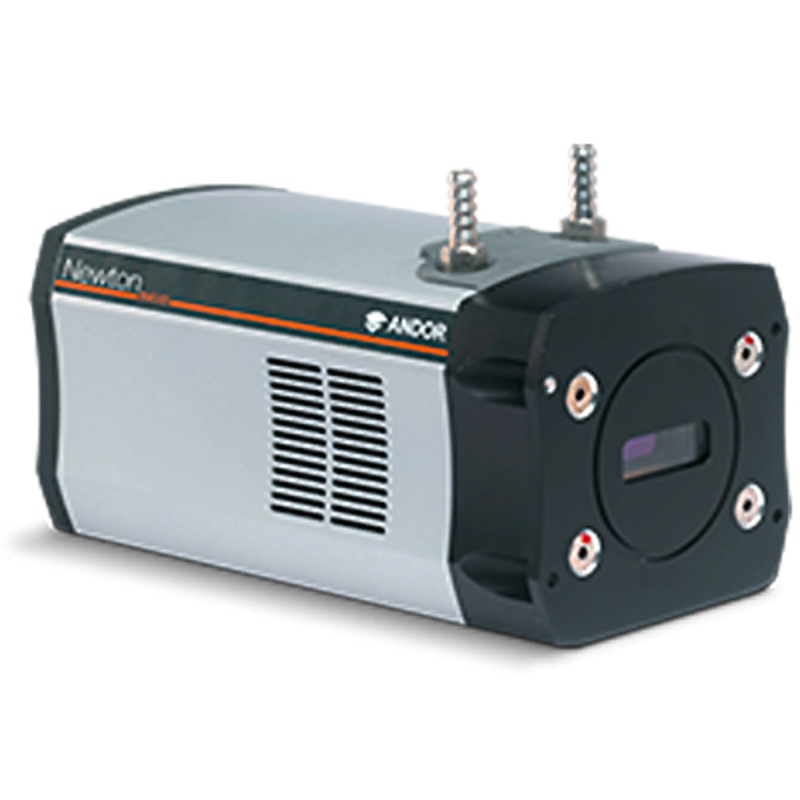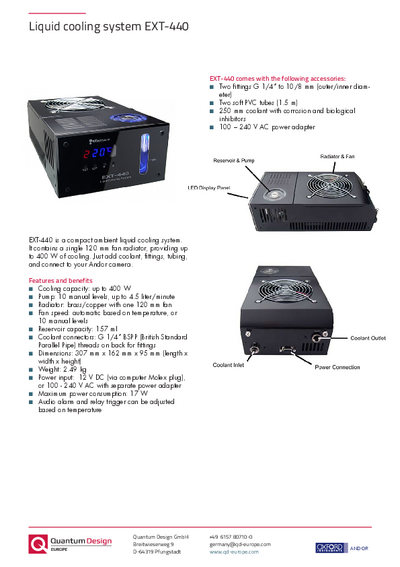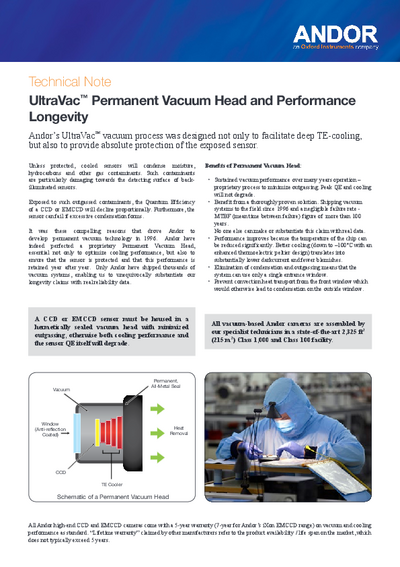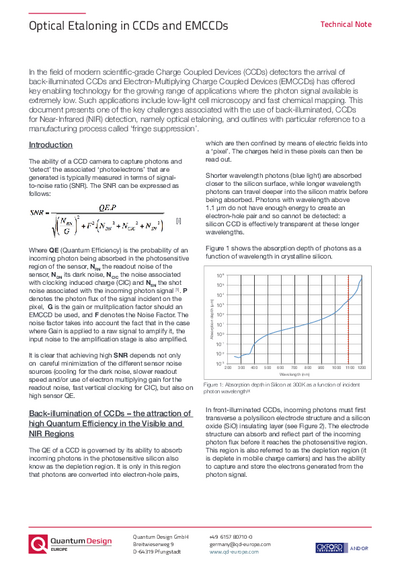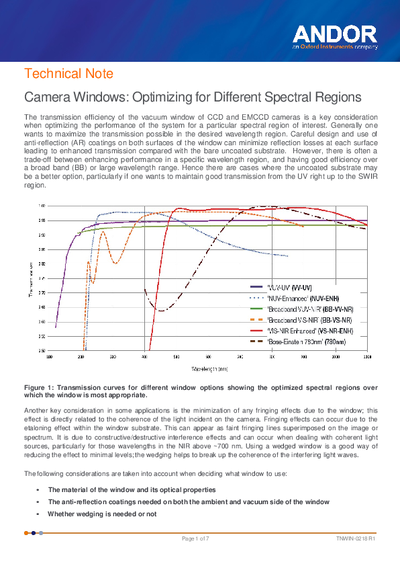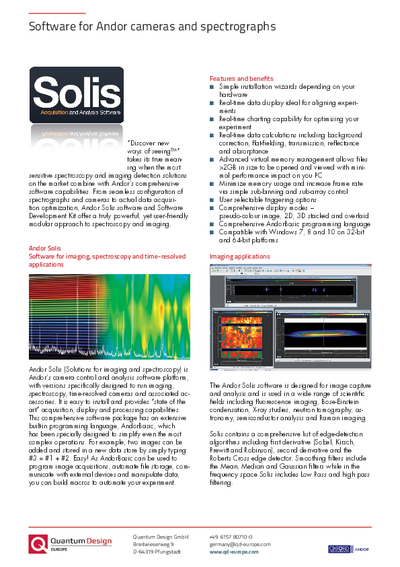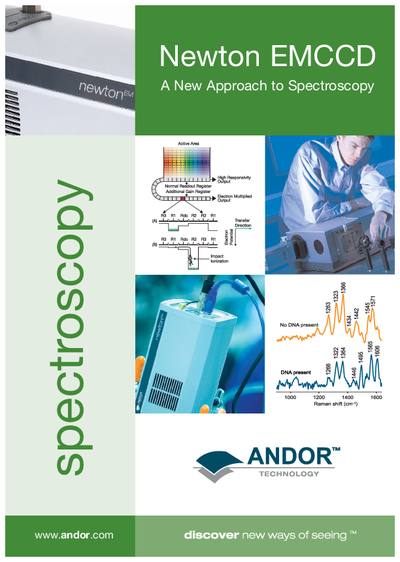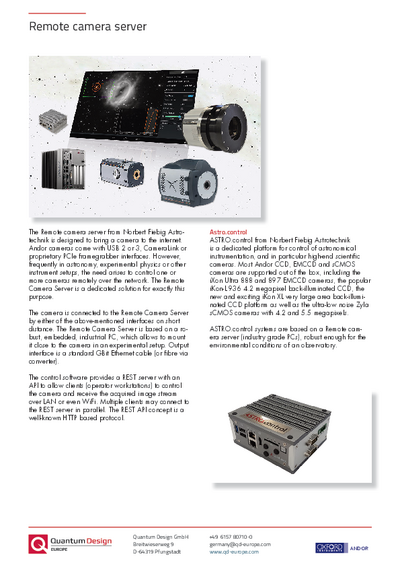EMCCD detectors for spectroscopy
Newton series from Oxford Instruments AndorFor ultra-sensitive spectroscopy applications, Oxford Instruments Andor offers the EMCCD cameras Newton 970 (1600 x 200 x 16 µm pixels) and the Newton 971 (1600 x 400 x 16 µm pixels) with USB 2 interface. The EMCCD sensor of the Newton detectors is placed in a sealed vacuum chamber so that temperatures down to -100 °C are achieved with thermo-electrical cooling.
- Effective read noise < 1 electron with electron multiplying gain for single photon sensitivity
- Two EMCCD sensor formats (1600 x 200 x 16 µm and 1600 x 400 x 16 µm) for high resolution spectroscopy
- Rapid spectrum rates up to 396 spectra/s (Newton 971) and 649 spectra/s (Newton 970) for full vertical binning and > 1.500 spectra/s for cropped sensor mode
- Front and back-illuminated sensors with > 90% quantum efficiency optimized for UV, VIS, and NIR (with Fringe suppression technology for Newton 970 back-illuminated sensor)
- Thermo-electrical cooling of EMCCD sensor to -100 °C for negligible dark current
Further information
The Newton EMCCD detectors are the market leaders for ultra-sensitive and ultra-fast spectroscopy. EM technology enables charge from each pixel to be multiplied on the sensor before readout resulting in single photon sensitivity. To provide unrivalled performance for demanding spectroscopic applications, the Newton EM platform combines a 1600 x 200 or 1600 x 400 array of high resolution 16 ?m pixels, low noise electronics, high quantum efficiency sensors, thermoelectric cooling down to -100°C for negligible dark current, 3 MHz readout and USB 2.0 plug-and-play connectivity. The dual output amplifiers allow software selection between either a conventional high sensitivity or electron multiplying outputs to suit a broad range of photon regime conditions. This makes the Newton EMCCD the ideal choice for ultra-fast and low light spectroscopy.
Specifications
Applications
Downloads
Videos
Reference customers
| Title | Author(s) | Institute | Year | Detector/Spectrograph |
|---|---|---|---|---|
| Raman | ||||
| Raman-Line imaging to investigate occurring transport mechanisms in aerogel production | J. Quino | Institute of Engineering Thermodynamics, Erlangen Untiversity, Germany | 2017 | Newton DU971P-BV, Shamrock SR-303i-A |
| Polarization-sensitive spontaneous Raman scattering spectroscopy | S. Rieger, C. Mannweiler, C. Fallnich | Institute of Applied Physics, University of Münster, Germany | 2016 | Newton DU970P-BVF Shamrock SR-500i-D1-SIL |
| Ultrafast time- and frequency- resolved coherent anti-Stokes Raman spectroscopy (CARS) with femtosecond excitation and picosecond probing | M. Lütgens, S. Chatzipapadopoulos, S. Lochbrunner | Institute of Physics, University of Rostock, Rostock, Germany | 2014 | Newton DU970P-BV |
| Raman-Line imaging to monitor diffusion kinetics | O. Knauer | Institute of Engineering Thermodynamics (LTT) and Erlangen Graduate School in Advanced Optical Technologies (SAOT), University Erlangen-Nuremberg, Germany | 2013 | Newton DU971N-BV |
| Increase of the threshold for stimulated Raman scattering by a spectral broadening of the excitation source | R. F. Hankel | Technical Thermodynamics, University of Erlangen-Nürnberg, Germany | 2012 | Newton DU971N-BV |
| Multiplex CARS Microscopy | T. Buckup, C. Pohling, M. Motzkus | Insitute of Physical Chemistry, University of Heidelberg, Germany | 2011 | Newton DU970N-BV |
| Tip-enhanced Raman spectroscopy with ultra high sensitivity | B. Pettinger, P. Schambach, N. Scott | Fritz Haber Institute of the Max Planck Society, Berlin, Germany | 2011 | Newton DU970N-BV |
| Using an EMCCD camera for high resolution one-dimensional Raman spectroscopy | O. Knauer | Institute of Technical Thermodynamics, University Erlangen-Nürnberg, Germany | 2010 | Newton DU971N-BV |
| Sum-frequency generation | ||||
| Spectrometer for broadband vibrational sum-frequency generation at fluid interfaces | N. García Rey, | Institute of Physical Chemistry, Westfälische Wilhelms-Universität Münster, Germany | 2019 | Newton DU970P-BVF Kymera-328i-D2-SIL |
| Spectral characterization of quantum light from an engineered Type-II sum-frequency generation process | M. Allgaier, V. Ansari, L. Sansoni, V. Quiring, R. Ricken, H. Suche, B. Brecht, C. Silberhorn | Integrated Quantum Optics Group, Department of Physics, University of Paderborn, Germany | 2016 | Newton DU970P-BVF Shamrock SR-500i-D1-SIL |
| Optically probing surface phonons using surface specific vibrational spectroscopy | R. Kramer Campen | Fritz Haber Institute of the Max Planck Society, Berlin, Germany | 2015 | Newton DU971P-BV |
| Enhanced ordering of water at hydrophobic surfaces measure with vibrational sum-frequency generation | J. Versluis, S. Strazdaite, H. J. Bakker | Ultrafast Spectroscopy, FOM Institute AMOLF, Amsterdam, The Netherlands | 2015 | Newton DU970P-BV |
| Femtosecond time-resolved electronic sum frequency generation for the investigation of optoelectronically relevant interfaces | L. Foglia, M. Wolf, J. Stähler | Fritz Haber Institute of the Max Planck Society, Berlin, Germany | 2015 | Newton DU970P-BV |
| Monolayer detection with sum-frequency generation spectroscopy | E. H. G. Backus, T. Weidner | Max Planck Institute for Polymer Research, Mainz, Germany | 2014 | Newton DU970P-BV |
| Interfacial Water Structure studied by Vibrational Sum Frequency Generation | M. Sovago, M. Bonn | AMOLF, Amsterdam, The Netherlands | 2009 | Newton DU970N-BV |
| Plasma | ||||
| Spectroscopic investigation of level population of sputtered tungsten in the linear plasma device PSI-2 | S. Ertmer, S. Brezinsek, A. Pospieszczyk, O. Marchuk, A. Kreter | Institute of Energy and Climate Research - Plasma Physics, Forschungszentrum Jülich GmbH, Association EURATOM-FZJ, Partner in the Trilateral Euregio Cluster, Jülich, Germany | 2019 | Newton DU971P-UVB Acton SpectraPro 750 |
| Ambient humidity has minor influence on OH emission of an atmospheric pressure argon plasma jet than feed gas humidity | J. Winter, M. Hänel, M. Dünnbier, S. Reuter | Centre for Innovation Competence (ZIK) plasmatis, Leibniz Institute for Plasma Science and Technology e.V. (INP Greifswald), Germany | 2014 | Newton DU971P-UVB |
| Spectroscopic Characterisation and Plasma Surface Interaction Experiments with the linear Plasma Simulator PSI-2 | S. Brezinsek, A. Pospieszczyk, A. Kreter, M. Laengner, M. Reinhart, B. Schweer, B. Unterberg | Institute for Energy- and Climate Research, Research Center Jülich, Association EURATOM-FZJ, Trilateral Euregio Cluster, Jülich, Germany | 2012 | Newton DU971P-UVB |
Spektral aufgelöste Beobachtung des Wiedereintritts der STARDUST-Kapsel | M. Winter, G. Herdrich | Institute of Space Systems, University of Stuttgart, Germany | 2006 | Newton DU971N-UVB Acton SpectraPro 300 |
| Fluorescence | ||||
Custom Designed Fluorescence Enhancing Hot Spot | M. Hallermann | Department of Physics and Center for NanoScience, Ludwig Maximilians University Munich, Germany | 2009 | Newton DU971N-UVB |
Trapped Ion Laser Induced Fluorescence | M. Kordel, L. Walter, D. Schooss, M. M. Kappes | Intitute of Nanotechnology, Karlsruhe Institute of Technology, Germany | 2008 |
|
| Photoluminescence | ||||
| Photoluminescence and valley polarization in two-dimensional semiconductors | R. H. Godiksen, A.G. Curto | Department of Applied Physics and Institute for Photonic Integration, Eindhoven University of Technology, Eindhoven, The Netherlands | 2019 | Newton DU970P-FI Shamrock SR-303i-A-B-SIL |
| Mikrophotolumineszenz- Spektroskopie von Halbleiter- Quantenpunkten | M. Kahl, R. Bratschitsch | Institute of Modern Optics and Quantum Electronics, University of Konstanz, Germany | 2007 | Newton DU970N-BV Acton DSP2500 |
| Frequency-resolved optical gating | ||||
| Sensitive interferometric frequency-resolved optical gating with an EMCCD based spectrometer | S. K. Das, M. Bock, G. Steinmeyer, R. Grunwald, T. Elsaesser | Max Born Institute for Nonlinear Optics and Short-Pulse Spectroscopy, Berlin, Germany | 2013 | Newton DU970N-UVB |
Navigation
Categories
Contact
Quantum Design AG
Route du Roule 41
CH-1723 Marly
Switzerland
| Phone: | +41 21 8699-033 |
| E-Mail: | suisse@qd-europe.com |

